
Okhotsk Chapter
of the Wild Bird Society of Japan

| Home | Events | Reports | Sightings | Checklist | Bird Guide |
| Birding Info | J Bird Names | References | Links | About Us | Contact Us |
| 2015 Seabirding | Back to Reports Top | ||||
Jump to Excursion II on 23 May
Jump to Excursion III on 1 August
Jump to Excursion IV on 31 October
Jump to Excursion V on 14 November
.jpg) |
| We had no photos of birds so we took this photo of ourselves instead. At the left is our knowledgeable guide Masayuki Miyamoto; in the green jacket is Kawasaki-san, head of the Okhotsk Chapter of the Wild Bird Society of Japan; next is Captain Maeda; and I'm in there, too. The land mass at the left is the Notoro Peninsula. The boat, of course, is Captain Maeda's Chipashiri, a great boat she is. |
This cruise was originally planned for 11:00 Saturday, the day before, but a low pressure system during the night brought strong winds and some rain. Though the wind subsided and sunshine returned in the morning, conditions at sea were still questionable for a small boat like the Chipashiri. The best way to check both birding and sea conditions was to go out of the harbor and look. Not far out, the Sea of Okhotsk greeted us with 2-meter waves rolling at us, and there were no birds around as well. We were about a kilometer out when Captain Maeda decided to turn the boat around and head back. Going up and down big waves like that was a new experience for most of us and we gained considerable respect for the sea. Coming back was much easier when the waves were welling up behind us and pushing the boat forward. Back on shore and our balance a bit wobbly, the cruise was rescheduled for the following morning at 6:00. All eight of us were pleased.
At this time of year, it is light by 5:00. Sunday morning, the weather was about the same, just slightly nippy, waves were down to about half a meter, and there were birds as well. These are perfect conditions, because when the boat is at the top of a wave, the birds are easier to see! The up-and-down rocking of the boat, however, was not ideal for taking photos. I could still see enough of the beauty of the birds in some of these shots that they are worth posting on a web page. Beauty is wherever you find it...
.jpg) |
.jpg) |
| Not hundreds but still many long-tailed ducks (Koori-gamo). | Pair of long-tailed ducks on quieter waters. | 440.jpg) |
440.jpg) |
| Large group of around 100 pelagic cormorants (Hime-u) | Group of great cormorants (Kawa-u) in breeding plumage (white at necks) |
440.jpg) |
.jpg) |
| Terribly out of focus but no mistaking that this is a thick-billed murre (Hashibuto-umigarasu) | ...and that these are harlequin ducks (Shinori-gamo). |
 |
 |
| Spotted seal (Gomafu-azarasi, adult) near the entrance to Notoro Lake, west of Cape Notoro | Spotted seal (young) at least 1 km offshore from the east coast of Cape Notoro |
Today's list (compiled by Kawasaki-san, Miyamoto-san, and Yamamoto-san): Whooper swan (Oo-hakuchou), Eurasian widgeon (Hidori-gamo), Mallard (Ma-gamo), Northern pintail (Onaga-gamo), Harlequin duck (Shinori-gamo), Velvet scoter (Biroodo-kinkuro), Long-tailed duck (Koori-gamo), Common goldeneye (Hoojiro-gamo), Common merganser (Kawa-aisa), Red-breasted merganser (Umi-aisa), Rock dove (Do-bato), Pacific loon (Shiroeri-oohamu), Pelagic cormorant (Hime-u), Great cormorant (Kawa-u), Japanese cormorant (Umi-u), Black-tailed gull (Umineko), Mew gull (Kamome), Glaucous gull (Shiro-kamome), Slaty-backed gull (Oo-seguro-kamome), Thick-billed murre (Hashibuto-umigarasu), Spectacled guillemot (Keimafuri), Ancient murrelet (Umisuzume), Rhinoceros auklet (Utou), Black Kite (Tobi), Large-billed crow (Hashibuto-garasu), Eurasian skylark (Hibari), White wagtail (Haku-sekirei). Marine mammal: Spotted seal (Gomafu-azarashi) [28 bird species]
Update (11 April): Miyamoto-san, our guide on the trip, reports that short-tailed shearwaters have already arrived in the Sea of Okhotsk from Tasmania, Australia. This is at least a week earlier than usual.
Information about Abashiri Nature Cruises can be found on their webpage (part of the Abashiri City Travel Site).
I love being out at sea. It is a place that never ceases to fascinate. It is also a place that demands respect, and when that respect is duly accorded, the experience of being there is that much more rewarding, either in the enjoyment of its abundant and ever-changing environment, or in a safe return to shore.
Today's cruise was organized and led by Yasuhiro Kawasaki, head of the Okhotsk Chapter of the Wild Bird Society of Japan, and was therefore very much a bird-focused journey. Most of the 18 people aboard the Chipashiri helmed by Captain Maeda of Abashiri Nature Cruises were WBSJ-Okhotsk members.
Though the weather was mostly sunny, the wind was up and sea conditions at first were not smooth. The Shiretoko mountains in the distance, still clad with some snow, were just visible in the haze. Captain Maeda steered the Chipashiri north where we saw the occasional Spectacled Guillemot (Keimafuri) flying above the water surface and Kittiwakes (Mitsuyubi-kamome) in small groups both flying and on the water. There were Rhinoceros Auklets (Utou) as well wherever we went, usually in isolated pairs.
.jpg) |
.jpg) |
| Above left: A young Spectacled Guillemot (Keimafuri) in flight. Above right: Kittiwake (Mitsuyubi-kamome) airborne, a young Slaty-backed Gull (Oo-seguro-kamome) to its left, and a Rhinoceros Auklet (Utou) in the foreground. Below: A group of Kittiwakes and a Rhinocerous Auklet (above right) among them. | |
.jpg) |
|
Then when Captain Maeda received a report that the wind was much less some kilometers to the east and conditions would be better to see birds, we headed that way, and after about 30 minutes the wind was indeed much less and the seas calmer, too. There are buoys of various kinds at many locations offshore, and when the sea is calm, at this time of year the most likely bird to be seen near them is the migrating Red-necked Phalarope (Akaeri-hireashi-shigi). Kawasaki-san explained that they assemble around buoys because this is where the small crustaceans, insects and the birds' other food sources are concentrated due to the manner in which the water current flowed around the buoys. These birds are also seen around floating items such as drift wood and seaweed. Today, the sea current and wind happened to be moving in the same direction, and the food sources thus flowed in a straight line from the buoys.
.jpg) |
.jpg) |
These beautiful birds are very easy to approach at a slow, gentle speed.
.jpg) |
.jpg) |
One migratory bird that we did not see on this cruise was the Short-tailed Shearwater (Hashiboso-mizunagidori) that we saw in huge numbers exactly two years ago (in our report here). At that time they appeared in several huge "rafts" on the sea that was very calm at the time. The newly-fledged Short-tailed Shearwaters should be arriving in about a month.
.jpg) |
.jpg) |
| Pair of Rhinoceros Auklets. | Minke whale of which there are many in these waters. |
The sea had calmed considerably during the three hours we were out, and the mountains also became easier to see. In the end it was a wonderful day out and our thanks go to Captain Maeda and our knowledgeable guide Kawasaki-san.
Today's list: Pelagic Cormorant (Hime-u), Great Cormorant (Kawa-u), Japanese Cormorant (Umi-u), Gray-tailed Tattler (Kiashi-shigi), Ruddy Turnstone (Kyoujo-shigi), Red-necked Phalarope (Akaeri-hireashi-shigi), Kittiwake (Mitsuyubi-kamome), Black-tailed Gull (Umineko), Slaty-backed Gull (Oo-seguro-kamome), Spectacled Guillemot (Keimafuri), Rhinoceros Auklet (Utou), Black Kite (Tobi), White-tailed Sea-Eagle (Ojiro-washi), Carrion Crow (Hashiboso-garasu), Thick-billed Crow (Hashibuto-garasu) [17 bird species]; plus Minke whale, and Harbor Porpoise (Nezumi-iruka; Phocoena phocoena).
In Abashiri there were severe thunderstorms and heavy rain the night before, and the rain did not stop until mid-morning today. The forecast was for rain to stop by noon and for clouds to clear during the afternoon. Perfect. But what about conditions at sea? There were about 11 of us this time. Captain Maeda of the Chipashiri told us that wind conditions at sea were still fairly strong but that we would go out anyway and return if it was too much. The first hour was indeed a bit rough, seas about one meter, spray pleasantly reminded a few of us at the front of the boat that seawater was indeed salty, but areas of blue were spreading in the sky, the tops of mountains appeared above the clouds on land, and it was just a matter time before we could do what we came out to do.
 |
 |
| Left: White-tailed Sea-Eagle (Ojiro-washi) on a concrete seawall by a lighthouse as we exit the harbor, a common sight in this area. Above: Slaty-backed Gull (Oo-seguro-kamome), a large gull, also very common year-round in eastern Hokkaido. |
It took another 30 minutes for us to see any more birds. Meanwhile, as we headed further out to sea in a northeasterly direction, the weather continued to improve and the wind abated.
 |
 |
| Thick-billed Murres (Hashibuto-umigarasu). This pair was the only one we saw on this excursion. Thick-billed Murres, when they were around, usually dived into the water when the boat approached, but this pair flew off. | |
 |
|
| Part of a flock of some 100 young Black-tailed Gulls (Umineko) aged 1-3 plus some adults, and a Slaty-backed Gull, the large one left of center, spotted on our way back to port. | |
 |
 |
| Left: Though the mission of this excursion was to see what birds we could find, inevitably there are some welcome distractions, such as around 300 Pacific White-sided Dolphins (Kama-iruka; Lagenorhynchus [Sagmatias?] obliquidens). Many of them were pups. Since there were few birds today, the dolphins turned out to be the high point of the trip. Above: Mt. Shari (1,547m) with Black-tailed Gulls in the foreground. | |
Today's list: Northern Fulmar ±10 (Furuma-kamome), Sooty Shearwater ±5 (Haiiro-mizunagidori), Flesh-footed Shearwater 3+ (Akaashi-mizunagidori), Pelagic Cormorant 1 (Hime-u), Great Cormorant (Kawa-u), Japanese Cormorant (Umi-u), Red-necked Phalarope ±30 (Akaeri-hireashi-shigi), Black-tailed Gull (Umineko), Slaty-backed Gull (Oo-seguro-kamome), Pomarine Skua 3+ (Touzoku-kamome), Common Murre 2 (Umigarasu), Rhinoceros Auklet 1 (Utou), White-tailed Sea-Eagle 1 (Ojiro-washi) [13 bird species]; plus Pacific White-sided Dolphin (Kama-iruka) and Harbor Porpoise (Nezumi-iruka; Phocoena phocoena). [Compiled by Yasuhiro Kawasaki, head of the Okhotsk Chapter of the WBSJ, and other participants]
This time, just three days later, I went out on my own with my wife and her high school student niece who was on summer holidays. She lives inland and had never been on a boat on the sea before. It was a gorgeous summer morning, likely to be fairly hot, and indeed haze prevented us from clearly seeing the mountains. Seas were mostly calm.
This was a regularly scheduled cruise, tailored to meet the main interests of participants. Besides us, there were a couple of families aboard whose main interests were marine mammals, so that's what Captain Maeda of the Chipashiri looked for first. Along the way, there were of course some birds as well, not in particularly large numbers, but the wildlife in the waters of the Sea of Okhotsk within a radius of about 12 km from Abashiri always changes, even on a daily basis, so it's always an adventure to go out.
 |
 |
| Left: Pacific Swifts (Amatsubame) in the sky above us. Above: One of them cropped from a photo when I could get one in better focus. |
|
 |
|
| Pomarine Skuas (Touzoku-kamome). There were four in this group. The dark one at the rear is likely a young bird since its tail feathers were not yet fully grown compared to the adults (thanks to Kawasaki-san for his feedback on this individual); there apparently also exist dark forms of this skua (Brazil, 2009). | |
 |
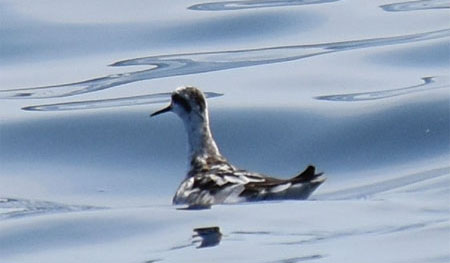 |
| Left: Northern Fulmar (Furuma-kamome), dark morph. Right: Red-necked Phalarope (Akaeri-hireashi-shigi) whose neck is no longer red due to the change in this season to winter plumage. We saw small groups of this bird several times during the cruise. | |
 |
Left: Black-tailed Gull (Umineko) backed by a cliff on the eastern side of the Notoro Peninsula. Below left: Dall's Porpoises (Ishi-iruka; Phocoenoides dalli) coming to the surface. Scenes like this were a regular occurrence for about 20 minutes as we circled around in the area. Below right: They were also close to the side of the boat, swimming toward the front where they emerged above the water and dove down again. |
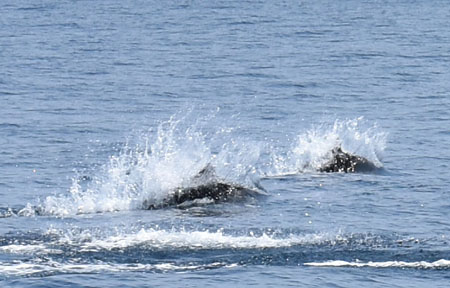 |
 |
The porpoises were at least 12 km out at sea, and when time came for us to return, Captain Maeda pointed the Chipashiri straight toward Abashiri port. We continued to see porpoises breaking the surface in the distance on both sides of the boat during the journey back, enjoyable flashbacks to our encounter with them earlier. I read later that there were "several hundreds of thousands of Dall's porpoises in the Okhotsk Sea" (NOAA Fisheries website, 2012).
900.jpg) |
I wanted to go out once this autumn before the regular sightseeing season for Abashiri Nature Cruises closed at the end of October. My wife and I booked several times, but each time the seas were too rough or the wind was too strong to go out and the cruise was canceled. Finally, in the afternoon of October 31, the last scheduled cruise of the season was allowed to leave the port and we were happily aboard.
Weather mostly cloudy, temps around 5°C, and seas rough at first but calmed down further out. Lots of birds and dolphins, too. Perfect again.
 |
 |
| Pacific Loon/Diver (Shiroeri-oohamu). | Kittiwake (Mitsuyubi-kamome), 1st winter. |
 |
|
| Red-breasted Mergansers (Umi-aisa). | |
 |
|
| Sooty Shearwaters (Haiiro-mizunagidori). | |
 |
|
| Ancient Murrelets (Umisuzume). | |
 |
|
| Rhinoceros Auklets (Utou) above; Ancient Murrelets (Umisuzume) below them. | |
 |
 |
| Above: Thick-billed Murre (Hashibuto-umigarasu). Right: Rhinoceros Auklet (Utou). |
|
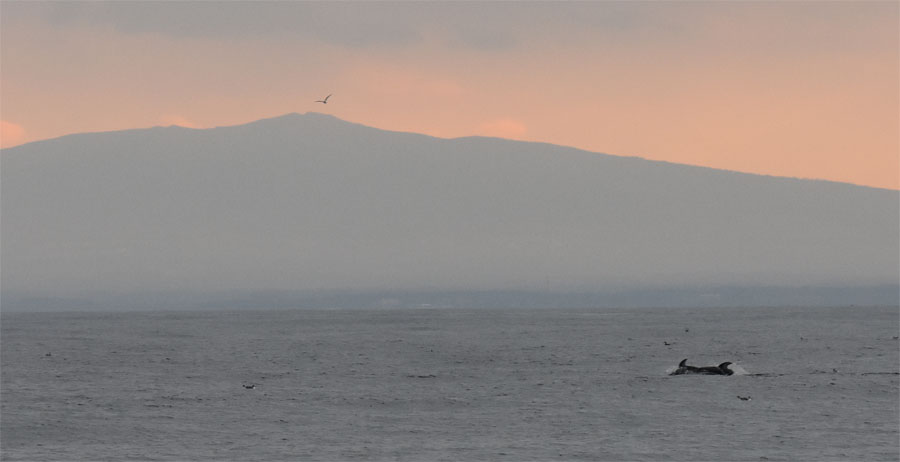 |
|
| En route back to port: More dolphins (Pacific white-sided; Kama-iruka), birds, and Mt. Mokoto in the fading light of day. | |
Many thanks to Captain Maeda of the Chipashiri and to the Abashiri Tourism Association for making these wonderful cruises possible again this season. Spring and the next cruising season is a long five months away, but we look forward to it very much, especially when the drift ice begins to break up and produce some breathtaking scenery.
Well, the October 31 excursion was indeed the last of the regular season, but it was not the end of the Okhotsk Chapter's excursions! Kawasaki-san, head of the Chapter, booked not only one but three more excursions for November, the first of which was last Saturday morning. One of the birds we will no doubt be keeping an eye out for Ross's Gull.
Weather was fine, partly cloudy, about 8°C, and the wind came up only on the way back, a southerly that had us plying against the wind and waves. By then the best of the birding had been done, including a visit with a pod of about 300 Pacific white-sided dolphins as an enjoyable afterthought.
This trip was significant as we saw a rare early winter visitor that breeds further north and winters only on the open sea: a Horned Puffin (Fratercula corniculata; juvenile). Another fairly rare find was a Tufted Puffin (Fratercula cirrhata; immature). (It is hard for me to tell the difference between a juvenile and an immature sometimes, so I defer to the experts for these identifications.) The overall numbers of birds were less than they were two weeks earlier, but the number of species was clearly up, probably thanks in part to the larger number of eyes looking for them!
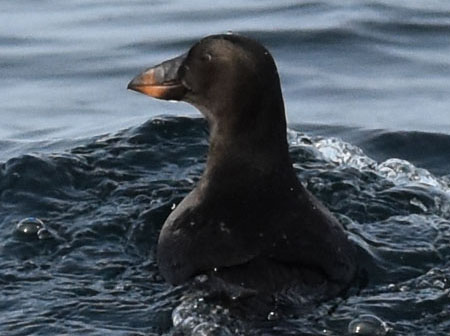 |
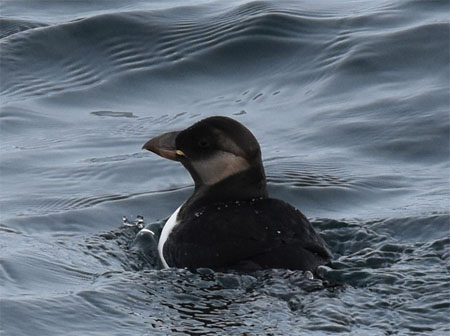 |
| Tufted Puffin (Etopirika), immature. Etopirika is an Ainu name meaning "beautiful bill". | Horned Puffin (Tsunomedori), juvenile. |
 |
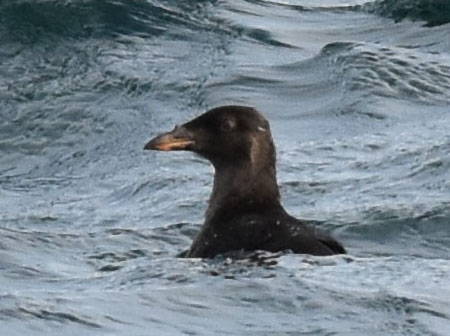 |
| Common Murre (Umigarasu). | Rhinoceros Auklet (Utou), winter plumage. |
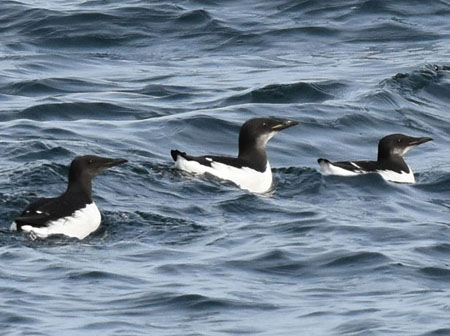 |
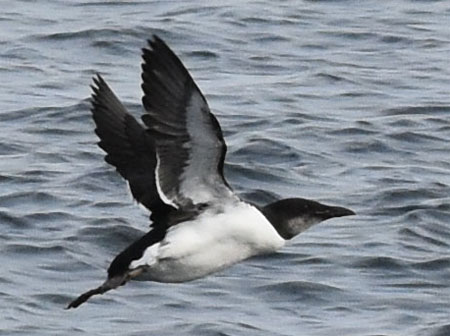 |
| Thick-billed Murres (Hashibuto-umigarasu). | Thick-billed Murre in flight. |
 |
 |
| Northern Fulmar (Furuma-kamome), dark morph. Unfortunately entangled in what looks like a fishing line. | Pacific Loon/Diver (Shiroeri-oohamu). |
 |
|
| Pacific Loons/Divers in flight. A bit out of focus but lets you compare how they look in flight. | |
 |
|
| Pacific White-sided Dolphin (Kama-iruka). About 300 of them today (Captain Maeda's count). | |
Today's list: Tufted Duck (Kinkuro-hajiro), Greater Scaup (Suzu-gamo), Harlequin Duck (Shinori-gamo), Black Scoter (Kuro-gamo), Common Goldeneye (Hoojiro-gamo), Red-breasted Merganser (Umi-aisa), Red-necked Grebe (Akaeri-kaitsuburi), Red-throated Loon (Abi), Black-throated Loon (Oohamu), Pacific Loon (Shiroeri-oohamu), Northern Fulmar (Furuma-kamome), Sooty Shearwater (Haiiro-mizunagidori), Short-tailed Shearwater (Hashiboso-mizunagidori), Pelagic Cormorant (Hime-u), Great Cormorant (Kawa-u), Japanese Cormorant (Umi-u), Eurasian Coot 1 (Ooban), Kittiwake (Mitsuyubi-kamome), Black-headed Gull (Yuri-kamome), Black-tailed Gull (Umineko), Mew Gull (Kamome), Glaucous-winged Gull (Washi-kamome), Glaucous Gull (Shiro-kamome), Herring Gull (Seguro-kamome), Slaty-backed Gull (Oo-seguro-kamome), Pomarine Skua (Touzoku-kamome), Thick-billed Murre (Hashibuto-umigarasu), Common Murre (Umigarasu), Ancient Murrelet (Umisuzume), Rhinoceros Auklet (Utou), Horned Puffin 1 adult winter & 1 juvenile (Tsunomedori), Tufted Puffin 2 immature (Etopirika), Black Kite (Tobi), White-tailed Sea-Eagle (Ojiro-washi), Stellar's Sea-Eagle 1 (Oo-washi), Eurasian Sparrowhawk (Hai-taka), Thick-billed Crow (Hashibuto-garasu), Tree Sparrow (Suzume) [38 bird species]; plus Pacific White-sided Dolphin (Kama-iruka). [Compiled by participants]
| Mar | Apr | May | Jun | Jul | Aug | Sep | Oct | Nov | |
|---|---|---|---|---|---|---|---|---|---|
| Land | 5 | 20, 30 | 7 | 3 | |||||
| Sea | 5, 8, 15, 19 | 23, 26, 27 | 23 | 1 | 7 | 10, 31 | 14 |
